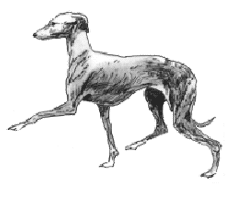Italian Greyhound
General Information - Italian Greyhound

Group:
Toy
Size:
small
Lifespan:
12-15 years
Exercise:
little
Grooming:
very little
Trainability:
moderate
Watchdog ability:
moderate
Protection ability:
very low
Area of Origin:
Italy
Date of Origin:
ancient times
Other Names:
Piccolo Levrieve
Italiani
Original Function:
Lapdog
History
The Italian Greyhound is a very old Greyhound. Interestingly, a dog similar to the Italian Greyhound of today was found in a 6000 year old Egyptian tomb. Like the Greyhound, this breed was brought to Europe by the Phoenicians. The breed was later developed by the Romans. As evidence, a small Greyhound was found in an ancient lava flow in Pompeii. During the sixteenth century, this delicate dog became popular with European nobility, and is portrayed in many paintings of that time. They rose to great heights of popularity in the Italian renaissance and gained their name then.
Temperament
The Italian Greyhound is a devoted and affectionate dog breed who makes a good companion. Headstrong and stubborn, the Italian Greyhound requires a consistent and firm leader. It loves to run and chase. It is extremely gentle and sensitive. Reserved, often timid, with strangers, it is devoted to its family and is good with children, and other dogs and pets. However, it can be easily injured by boisterous children and larger dogs. While Italian Greyhounds like to please, bad habits have to be discouraged right from the beginning.
Upkeep
The Italian Greyhound likes a daily romp outdoors, but it hates the cold. Its exercise needs are best met with a good walk on leash or even a rollicking game indoors. It also likes to stretch out and sprint in a fenced area. This breed cannot live outdoors, unless the kenneling is well insulated and the run covered and is situated in a sunny sheltered area. . Care of the fine short hair is minimal, consisting only of occasional brushing to remove dead hair. Regular brushing of the teeth is important in this breed.
Italian Greyhound
A breed standard is the guideline which describes the ideal characteristics, temperament, and appearance of a breed and ensures that the breed is fit for function with soundness essential. Breeders and judges should at all times be careful to avoid obvious conditions and exaggerations, as well as being mindful of features which could be detrimental in any way to the health, welfare or soundness of this breed.
Breed Standard - Italian Greyhound
 General Appearance:
General Appearance: A greyhound in miniature, more slender in all proportions.
Characteristics: Elegant, graceful and quick moving.
Temperament: Intelligent, affectionate and vivacious; may appear aloof.
Head and Skull: Skull long, flat and narrow, slight stop. Muzzle fine and long. Nose dark in colour.
Eyes: Rather large, bright; full of expression.
Ears: Rose-shaped, placed well back, soft and fine, not pricked.
Mouth: Jaws strong, with a perfect, regular and complete scissor bite, i.e. upper teeth closely overlapping lower teeth and set square to the jaws. Teeth even.
Neck: Long, gracefully arched.
Forequarters: Shoulders long and sloping. Legs straight; well set under shoulders; fine, strong bone and pasterns.
Body: Chest deep and narrow. Good length of rib and brisket. Back slightly arched over loin.
Hindquarters: Long, well-muscled thigh - hind legs parallel when viewed from behind; well bent stifle, hocks well let down.
Feet: Hare feet.
Tail: Low-set, long, fine, carried low.
Gait/movement: High-stepping and free action. Front and hindlegs to move forward in a straight line with propulsion from behind.
Coat: Skin fine and supple. Hair, short, fine and glossy.
Colour: Black, blue, cream, fawn, red, white, or any of these colours broken with white. White dogs may be broken with one of these colours. Black or blue with tan markings, or brindle not acceptable.
Size: Ideal Height 32 - 38cms (12½ - 15 ins) at withers. Ideal Weight 3.6 - 4.5 kgs (8 - 10 lbs). Overall type and elegance essential.
Faults: Any departure from the foregoing points should be considered a fault and the seriousness with which the fault should be regarded should be in exact proportion to its degree and its effect upon the health and welfare of the dog and on the dog’s ability to perform its traditional work.
Note: Male animals should have two apparently normal testicles fully descended into the scrotum.
DNZ No 128
Copyright Dogs New Zealand
07 Jul 2016
Any departure from the foregoing points should be considered a fault and the seriousness with which the fault should be regarded should be in exact proportion to its degree and its effect upon the health and welfare of the dog and on the dog’s ability to perform its traditional work.




